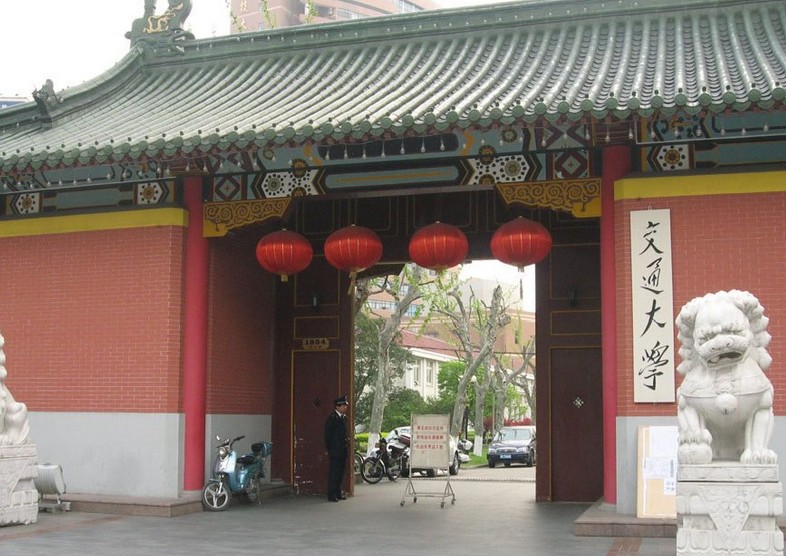
上海交通大学是我国历史最悠久、享誉海内外的高等学府之一,是教育部直属并与上海市共建的全国重点大学。经过119年的不懈努力,上海交通大学已经成为一所“综合性、研究型、国际化”的国内一流、国际知名大学。
十九世纪末,甲午战败,民族危难。中国近代著名实业家、教育家盛宣怀和一批有识之士秉持“自强首在储才,储才必先兴学”的信念,于1896年在上海创办了交通大学的前身——南洋公学。建校伊始,学校即坚持“求实学,务实业”的宗旨,以培养“第一等人才”为教育目标,精勤进取,笃行不倦,在二十世纪二三十年代已成为国内著名的高等学府,被誉为“东方MIT”。抗战时期,广大师生历尽艰难,移转租界,内迁重庆,坚持办学,不少学生投笔从戎,浴血沙场。解放前夕,广大师生积极投身民主革命,学校被誉为“民主堡垒”。
新中国成立初期,为配合国家经济建设的需要,学校调整出相当一部分优势专业、师资设备,支持国内兄弟院校的发展。五十年代中期,学校又响应国家建设大西北的号召,根据国务院决定,部分迁往西安,分为交通大学上海部分和西安部分。1959年3月两部分同时被列为全国重点大学,7月经国务院批准分别独立建制,交通大学上海部分启用“上海交通大学”校名。历经西迁、两地办学、独立办学等变迁,为构建新中国的高等教育体系,促进社会主义建设做出了重要贡献。六七十年代,学校先后归属国防科工委和六机部领导,积极投身国防人才培养和国防科研,为“两弹一星”和国防现代化做出了巨大贡献。
改革开放以来,学校以“敢为天下先”的精神,大胆推进改革:率先组成教授代表团访问美国,率先实行校内管理体制改革,率先接受海外友人巨资捐赠等,有力地推动了学校的教学科研改革。1984年,邓小平同志亲切接见了学校领导和师生代表,对学校的各项改革给予了充分肯定。在国家和上海市的大力支持下,学校以“上水平、创一流”为目标,以学科建设为龙头,先后恢复和兴建了理科、管理学科、生命学科、法学和人文学科等。1999年,上海农学院并入;2005年,与上海第二医科大学强强合并。至此,学校完成了综合性大学的学科布局。近年来,通过国家“985工程”和“211工程”的建设,学校高层次人才日渐汇聚,科研实力快速提升,实现了向研究型大学的转变。与此同时,学校通过与美国密西根大学等世界一流大学的合作办学,实施国际化战略取得重要突破。1985年开始闵行校区建设,历经20多年,已基本建设成设施完善,环境优美的现代化大学校园,并已完成了办学重心向闵行校区的转移。学校现有徐汇、闵行、黄浦、长宁、七宝、浦东等校区,总占地面积4893亩。通过一系列的改革和建设,学校的各项办学指标大幅度上升,实现了跨越式发展,整体实力显著增强,为建设世界一流大学奠定了坚实的基础。
交通大学始终把人才培养作为办学的根本任务。一百多年来,学校为国家和社会培养了20余万各类优秀人才,包括一批杰出的政治家、科学家、社会活动家、实业家、工程技术专家和医学专家,如江泽民、陆定一、丁关根、汪道涵、钱学森、吴文俊、徐光宪、张光斗、黄炎培、邵力子、李叔同、蔡锷、邹韬奋、严隽琪、陈敏章、王振义、陈竺等。在中国科学院、中国工程院院士中,有200余位交大校友;在国家23位“两弹一星”功臣中,有6位交大校友;在18位国家最高科学技术奖获得者中,有3位来自交大。交大创造了中国近现代发展史上的诸多“第一”:中国最早的内燃机、最早的电机、最早的中文打字机等;新中国第一艘万吨轮、第一艘核潜艇、第一艘气垫船、第一艘水翼艇、自主设计的第一代战斗机、第一枚运载火箭、第一颗人造卫星、第一例心脏二尖瓣分离术、第一例成功移植同种原位肝手术、第一例成功抢救大面积烧伤病人手术,第一个大学翻译出版机构,数量第一的地方文献,国内第一位欧洲科学院人文社科院士等,都凝聚着交大师生和校友的心血智慧。改革开放以来,一批年轻的校友已在世界各地、各行各业崭露头角。
截至2014年12月,学校共有28个学院/直属系,27个直属单位,16家附属医院,全日制本科生(国内)15971人、研究生(国内)29895人(其中全日制硕士研究生13746人、全日制博士研究生6274人),学位留学生1869;有专任教师2823名,其中教授862名;中国科学院院士20名,中国工程院院士22名,中组部顶尖“千人计划”1名入选中组部“千人计划”94名,“青年千人”60名,“长江学者”特聘教授和讲座教授共130名,国家杰出青年基金获得者107名,国家重点基础研究发展计划(973计划)首席科学家35名(青年科学家2名),国家重大科学研究计划首席科学家14名,国家基金委创新研究群体11个,教育部创新团队21个,上海交通大学位列科技部“国家创新人才培养示范基地”。
学校现有本科专业62个,涵盖经济学、法学、文学、理学、工学、农学、医学、管理学和艺术等九个学科门类;拥有国家级教学及人才培养基地12个,国家级校外实践教育基地9个,国家级实验教学示范中心7个,国家级虚拟仿真实验教学示范中心2个,国家工程实践教育中心5个,上海市实验教学示范中心9个;有国家级教学团队8个,上海市教学团队15个;有国家级教学名师8人,上海市教学名师36人;有国家级精品课程46门,国家级视频公开课12门,国家级精品资源共享课程23门,上海市精品课程142门;有国家级双语示范课程7门,上海高校示范性全英语课程10门。
学校现有一级学科博士学位授权点36个,覆盖经济学、法学、文学、理学、工学、农学、医学、管理学等8个学科门类;一级学科硕士学位授权点57个,覆盖全部13个学科门类;博士专业学位授权点3个;硕士专业学位授权点23个;32个博士后流动站;1个国家实验室(筹),8个国家重点(级)实验室,5个国家工程研究中心,3个国家工程实验室,2个国家级研发中心,1个国防重点学科实验室,3个协同创新中心,1个国际联合实验室,16个教育部重点实验室,4个卫生部重点实验室,1个农业部重点实验室,31个上海市重点实验室,5个教育部工程研究中心,7个上海市工程技术研究中心,1个国家社科基金决策咨询点,2个文化部文化产业研究基地,8个上海市理论创新基地、智库和经济社会发展研究工作室,3个世界卫生组织合作中心,1个国家技术转移中心和1个国家大学科技园。
科学研究与科技创新水平不断提高。2014年,国家自然科学基金项目数和经费数连续五年全国第一。SCI收录论文数等指标连续多年名列国内高校前茅,2013年度SCI收录论文数4901篇,继续保持全国高校第二;2004-2013年SCI收录论文累积被引21694篇、234209次,继续保持全国高校第三;“表现不俗”论文1922篇,上升至全国高校第二;在各学科期刊影响因子前十分之一的期刊发文达到686篇,上升至全国高校第二;作为第一作者发表国际合著论文1058篇,上升至全国高校第二;在四大名刊发表论文9篇,居全国高校第三;在中国科学技术信息研究所公布的153种各学科高影响力期刊中发文188篇,名列全国高校第三; 国内科技论文数7265篇,国内被引30177次,居全国高校第二。
拥有“暗物质探索研究”、“第二代高温超导带材制造”、“量子信息存储”、“国家水体安全的环境战略-洱海水治理”、“4500米无人遥控潜水器(海马号)研制”、“火箭发动机关键部件加工”、“纳米材料全新力学现象”、“合成光学活性无机材料”、“DNA磷硫酰化修饰基因组图谱破译”、“肾上腺肿瘤致病基因”、“肾上腺和胰腺内分泌肿瘤医学基因组学”、“胃癌发生机制”、“生态系统镁研究”、“生长素调控植物气孔发育”、“水稻花器官发育”、“为治疗非酒精性脂肪肝寻找潜在新靶点”、“治疗帕金森症天然产物”等一批重大研究成果。
上海交通大学深厚的文化底蕴,悠久的办学传统,奋发图强的发展历程,特别改革开放以来取得的巨大成就,为国内外所瞩目。这所英才辈出的百年学府正乘风扬帆,以传承文明、探求真理为使命,以振兴中华、造福人类为己任,向着“综合性、研究型、国际化”的世界一流大学目标奋进!
Shanghai Jiao Tong University (SJTU), as one of the higher education institutions which enjoy a long history and a world-renowned reputation in China, is a key university directly under the administration of the Ministry of Education (MOE) of the People's Republic of China and co-constructed by MOE and Shanghai Municipal Government. Through 119 years' unremitting efforts, SJTU has become a comprehensive, research-oriented, and internationalized top university in China.
By December 2013, SJTU has had 28 schools/departments, 26 directly-affiliated institutions, 12 affiliated hospitals, with 16,099 undergraduates and 27,921 postgraduates (13,345 master degree candidates and 6,287 doctorate degree candidates). The university faculty includes 2,851 full-time teachers (among which 872 are professors), 18 members of Chinese Academy of Sciences, 22 members of Chinese Academy of Engineering, 1 selected in "Thousand Talents Top Program" of the Organization Department of CPC Central Committee, 71 involved in "Thousand Talents Long-term Program", 6 elected in "Thousand Talents Foreign Experts Program", 7 involved in "Short-term Program", 56 chosen in "Young Talents Program", 117 Distinguished Professors and Chair Professors of "Cheung Kong Scholar Program", 98 winners of China National Funds for Distinguished Young Scientists, 30 Chief Scientists of the Major State Basic Research Development Program of China (973 Program), 14 Chief Scientists of the State Key Scientific Research Program, 9 Innovation Research Groups, National Natural Science Foundation of China and 20 Innovation Teams, MOE.
Today SJTU has 64 undergraduate programs covering 9 major disciplines: economics, law, literature, science, engineering, agriculture, medicine, management and arts. With 11 National Teaching and Talents Cultivation Bases, 7 National Off-campus Practice Education Bases, 6 National Experimental Teaching Demonstration Centers, 5 National Engineering Practice Education Centers, and 4 Shanghai Municipal Experiment Teaching Demonstration Centers, SJTU has 8 national-level teaching groups, 15 Shanghai Municipal teaching groups, 8 nationally renowned teachers and 36 Shanghai locally renowned teachers and owns 46 national-level quality courses, 13 national-level video-recorded open courses, 18 national-level quality resource-sharing courses, 134 Shanghai Municipal quality courses, 7 bilingual-teaching demonstration courses, and 6 Shanghai higher education all-English demonstration courses.
Up to now SJTU has 36 first-level disciplines authorized to offer doctorate degree covering 8 fields: economics, law, literature, science, engineering, agriculture, medicine and management; 57 first-level disciplines authorized to offer master degree covering all the 13 discipline fields; 3 disciplines authorized to offer professional doctorate degree; 21 disciplines authorized to offer professional master degree; 9 national first-level key disciplines, 11 national second-level key disciplines, 7 nationally-supported key disciplines, 55 Shanghai municipally-constructed key disciplines; 28 mobile post-doctoral stations; 1 state laboratory (under preparation), 8 state key laboratories, 5 national engineering research centers, 3 national engineering laboratories, 2 national R&D centers, 1 national-defense key discipline laboratory, 16 key laboratories of MOE, 4 key laboratories of National Health and Family Planning Commission, 1 key laboratory of Ministry of Agriculture, 30 key laboratories of Shanghai Municipal Government, 5 engineering research centers of MOE, 6 engineering technology research centers of Shanghai, 1 National Social Science Fund consultation spot, 2 research bases for cultural industries, Ministry of Culture, 8 theoretical innovation bases, think tank and economic and social development research office of Shanghai, 3 WHO collaborating centers, 1 National Technology Transfer Center, and 1 National University Science Park.
SJTU enjoys an increasingly high scientific research level and technology innovation level. Since 2013, SJTU has ranked first for four consecutive years in terms of the project number and the amount of money issued by National Natural Science Foundation of China. The number and other indexes of SCI papers of SJTU rank among the top for years, with 4,146 SCI papers in 2012 remaining the second among all the universities in China. The total number of SCI-cited papers from 2003 to 2012 reaches 23,655, with 171,550 times of citation, which keeps ranking the third in China. 1,041 papers were regarded as "doing-a-good-job" papers, ranking the third in China. 409 papers in different fields were published on journals whose Impact Factors are among the top 10 percent, ranking the fourth in China. 753 co-authored papers with SJTU as the first-author affiliation were published on international journals, ranking the third. 4 papers were selected in the "100 most influential international academic papers in China 2012", ranking the third. 7,650 sci-tech papers were published domestically, with 34,028 times of citation nationwide, remaining the first in China. 231 papers were published on SSCI and A&HCI journals, ranking the third among all the universities in China.
With profound cultural background, an age-old tradition on education, strenuous development history, and great achievements made since the reform and opening up, SJTU has attracted wide attention both inside and outside China. Carrying the mission of preserving cultural heritage, and seeking for the truth, bearing the responsibility of invigorating the Chinese nation and developing for the benefits of mankind, today this centennial university is sailing for the aim of becoming a comprehensive, research-oriented and internationalized world-class university.